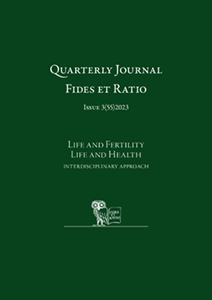Abstract
Abstract : Meticulous and systematic observation of the menstrual cycle allows a woman to monitor her procreative health, which has great diagnostic value. It gives the opportunity to learn about the natural rhythm of fertility and, in the case of observing abnormalities, reduces the time until the first medical consultation. Reliable learning of observation takes time and is carried out through a certified teacher of a particular method of fertility awarness.. Therefore, this skill from the area of prevention and diagnosis should occupy an important place in the teaching of both health care workers and the education of women themselves. In Poland, there are several non-governmental non-profit organizations that provide professional teaching support in the field of health-promoting education and natural family planning. Method: I and III of self- cycle observation chart were studied. The total number of analyzed charts was 74. The study was based upon the SPSS Statistics package version 25. The p < 0.05 level was considered statistically significant. Results: The majority of women with high self-observation skills in menstrual cycle charting using the double-check symptom-thermal method were single , with a university degree (53.65%, n=22), learning the method at the Lublin branch of Polish Association of Natural Family Planning Teachers (51.21%, n=21), motivated to learn charting for procreative health monitor (75.60%, n=31), with no support from a husband/fiancé/partner (60.96%, n=25). Conclusions: : The study group of women was homogeneous in terms of the eligibility criteria applied, i.e. they were all at reproductive age, had typical cycles and did not use contraception methods. The women's high skills in cycles self-observation are the result of the excellent quality of the NFP teacher work with the client, the ability to communicate and convey the principles of self-observation skills as well as the user's motivation to keep charting their cycles. The main goal of the women learning the method was to monitor their own procreative health.
References
Ayoola, A.B., Zandee, G.L., Adams, Y.J. (2016). Women’s Knowledge of ovulation, the Menstrual cycle, and Its Associated Reproductive Changes, Birth, 43(3), 255-262. https://doi.org/10.1111/birt.12237
Crawford, N.M., Pritchard, D.A., Herring, A.H., Steiner, A.Z. (2017). Prospective evaluation of luteal phase lenght and natural fertility, Fertility and Sterility, 107(3), 749-755. https://doi.org/10.1016/j.fertnstert.2016.11.022
Duane, M., Stanford, J.B., Porucznik, Ch., A. Vigil, P. (2022). Fertility Awareness-based Methods For Women’s Health And Family Planning, Frontiers In Medicine, 9, https://doi.org/10.3389/fmed.2022.858977
Ecochard, R., Duterque, O., Leiva, R., Bouchard, T., Vigil, P. (2015). Self-identification of the clinical fertile window and the ovulation period. Fertility and Sterility, 103(5), 1319-1325. http://dx.doi.org/10.1016/j.fertnstert.2015.01.031
Fertility Awarness based method a medical update FACTS, Natural Womenhood, (2016). (From:) https://naturalwomanhood.org/wp-content/uploads/NW-FACTS-Brochure-Jan-2016-update-FINAL-updated.pdf (access: 01.07.2023).
Hampton K.D., Mazza D., Newton J.M. (2012). Fertility-awareness knowledge, attitudes, and practices of women seeking fertility assistance. Journal of Advanced Nursing. 69(5), 1076–1084. https://doi.org/10.1111/j.1365-2648.2012.06095.x
Kinle, M., Szymaniak, M. (2009). Fazy cyklu miesiączkowego i objawy płodności w cyklu miesiączkowym. (W:) M. Troszyński (red.), Rozpoznawanie płodności. Materiały edukacyjno-dydaktyczne dla nauczycieli NPR, pracowników służby zdrowia oraz zainteresowanych zdrowiem prokreacyjnym, 59-70. Warszawa: Polskie Stowarzyszenie Nauczycieli Naturalnego Planowania Rodziny.
Kuźmiak, M., Szymaniak, M. (red.), (2014). Rozpoznawanie płodności, metoda objawowo-termiczna podwójnego sprawdzenia, praktyczny kurs dla użytkownika metody, podręcznik, Warszawa: Polskie Stowarzyszenie Nauczycieli Naturalnego Planowania Rodziny
Lundsberg, L.S., Pal, L., Gariepy, A.M., Xu, X., Chu, M.C., Illuzzi, J.L. (2014). Knowledge, attitudes, and practices regarding conception and fertility: a population-based survey among reproductive-age United States women, Fertility and Sterility, 101(3), 767-774. http://dx.doi.org/10.1016/j.fertnstert.2013.12.006
Najmabadi, S., Schliep, K.C., Simonsen, S.E., Porucznik, Ch.A., Egger, M.J. & Stanford, J.B. (2021). Cervical mucus patterns and the fertile window in women without known subfertility: a pooled analysis of three cohorts, Human Reproduction, 36(7), 1784-1795. https://doi.org/10.1093/humrep/deab049
Notare, T. (2019). Humanae Vitae, 50 years later. Embracing Gods Vision for Marriage, Love, and Life; A Compendium. Edited. Washington: The Catholic University Of America Press. https://doi.org/10.2307/j.ctvkjb333
Piasecka, K., Łyszczarz, P., Pytka, M., Ślizień-Kuczapska, E., Kanadys, K. (2022). Analiza kart obserwacji cykli w grupie kobiet w wieku prokreacyjnym. Kwartalnik Naukowy Fides et Ratio, 3(51), 41-51. https://doi.org/10.34766/fetr.v3i51.1115
Tawara, F., Tamura, N., Suganuma, N., Kanayama, N. (2012). Changes in cervical neutrophil elastase levels during the menstrual cycle, Reproductive Medicine and Biology, 11(1), 65-68. https://doi.org/10.1007/s12522-011-0104-7
Smyczyńska, J. (2019). Diagnostyka i leczenie zaburzeń hormonalnych jako wyraz troski o zdrowie prokreacyjne i profilaktyka niepłodności.: Czy metody rozpoznawania płodności mogą być pomocne? Kwartalnik Naukowy Fides et Ratio, 39(3), 44-57. https://doi.org/10.34766/fetr.v3i39.119
Ślizień-Kuczapska, E., Smyczyńska, J., Rabijewski, M. (2020). Wybrane zagadnienia zaburzeń kształtowania się zdrowia prokreacyjnego u dziewcząt. Czy warto włączyć obserwację cyklu do praktyki lekarskiej? Kwartalnik Naukowy Fides et Ratio 3(43), 303-319. https://doi.org/10.34766/fetr.v43i3.318
Ślizień-Kuczapska, E., Żukowska-Rubik, M., Sys, D. (2018). W trosce o rozwój zdrowia prokreacyjnego rodziny. Poradnictwo medyczne i pozamedyczne w promocji karmienia piersią oraz zagadnień naturalnego powrotu płodności po porodzie. Kwartalnik Naukowy Fides et Ratio, 2(34), 50-73. https://www.fidesetratio.com.pl/Presentations0/2018-04Kuczapska.pdf

